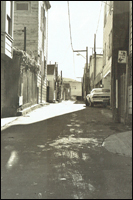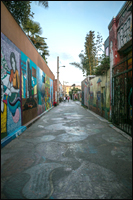In spring of 2004 CAMP organizers Megan Wilson and Aaron Noble co-taught the course SOLID/ FLUID:Approaches to Painting in Public to undergraduate and graduate students at the San Francisco Art Institute through the Painting Department. The class met Monday through Friday from 9:00 am to 6:00 pm March 15th – 26th .
Course Description:
The option of public art practice has enjoyed an explosive surge in the past decade, particularly in the Bay Area. Thanks in part to the lingering critical disrepute of community mural projects and the criminality and communal aesthetics of spraycan art, public painting remains an arena in which practice is ahead of theory. Following the first day of class, this intensive will be held off campus. Each day will begin with a breakfast discussion at Intersection for the Arts (446 Valencia Street in the Mission District), followed by on-site study, guest presentations and project work. The discussion portion of the course will analyze the formal openings created by the decision to move outside of the gallery system and review strategies running the gamut from the autonomy of illegal or quasi-legal postering, stickering or stenciling to the complex social negotiation of permissioned projects operating with public funding. Following introductory readings and discussion the class will choose a topic of common concern to respond to in two parts. Solid group will create a semi-permanent public mural while Fluid group creates a linked project utilizing ephemeral strategies.
Assigned Readings:
In our choice of readings for the class we wanted to avoid the standard mural/ public art histories, especially since the class would have the opportunity to get some of that material directly from guests like Ray Patlan, and instead followed some supplementary tracks. Several readings evoked versions of the larger situation of the class itself: that of a group of talented individuals embarked on a collective adventure in consciousness. X-men, Situationists, Merry Pranksters, and finally groups of Gnostics of the early Christian era all provided analogies and strategies for our group practice. The archetype of the trickster emerges to suggest a necessary function of the artist in our image intensive culture in the persons of Simon Magus, Ken Kesey, Yayoi Kusama, Tibor Kalman, and others, while the nature of that culture is discussed (with Guy Debord’s Society of the Spectacle as a baseline definition) with works by Nicholas Bourriaud, Naomi Klein, Eric Schlosser, Kalle Lasn, Adbusters, and Vandana Shiva.

- X-men #59 by Neal Adams & Roy Thomas
- Long Walk of the Situationist International by Greil Marcus; selections from the Situationist International Anthology, ed. Ken Knabb
- From Relational Aesthetics by Nicholas Bourriaud
- Interview with Yayoi Kusama
- From The Electric Kool-Aid Acid Test by Tom Wolfe
- From Trickster Makes this World by Lewis Hyde
- From Fast Food Nation by Eric Schlosser
- Poverty & Globalism by Vandana Shiva (presented on the BBC in 2000)
- Interview with Tibor Kalman
- From Culture Jamming by Kalle Lasn
- From Adbusters
- From No Logo by Naomi Klein
-
From The Gnostics by Jacques LaCarriere
Students included: Georgina Barney, Helen Bayly, Alex Braubach, Suzie Buchholz, Tom Farthing, Mei-Tsung Lee, Alice McGinn, America Meredith, Seija Metsola, Brooke Ripley, Ryan Rivadeneyra, Erin Ruch, and Rebecca Young.
Class Considerations & Partnerships:
Prior to the class, we secured space for the mural on the side of Community Thrift (Valencia Street between Clarion Alley and Sycamore) in the Mission District. Community Thrift is a non-profit resale organization that recycles and distributes donated goods throughout the Bay Area, generating funds that benefit over 200 local charities.
In response to the mural site the class began work with discussions around recycling and distribution. The Community Thrift wall has a preexisting sign at the loading dock that reads: “No Dumping,” an effort to control the flow of unsolicited after-hours donations. Working from this we talked about the many forms of commodity dispersal in the world & their positive and negative effects. This led to numerous mural design ideas, mostly working with objects from the thrift store in different ways, while the Fluid group discussed the marketing & movement of commodities, new and used, and possible interventions in those systems. We discovered paradoxes– for example that Community Thrift sends more clothing for recycling than it puts out for sale. We learned of a region in Africa in which well-intentioned clothing donations have damaged the local textile industry.
Ryan Rivadeneyra’s idea of using priority mail stickers from the post office in the Fluid project led to the natural observation that the postal system was another major form of dispersal. We decided to detourn the priority mail design scheme into both the Solid and Fluid projects. Another breakthrough came when it was pointed out that the mural was on Sycamore Street, and the Sycamore tree was known for its winged seedpods that helicopter through the air in a spectacular natural dispersion.Tom Farthing from Solid group instantly remembered the method for constructing simple paper helicopters that work on the same principal, and this was taken up as both a visual design and a distribution method for the Fluid project. Images of the seedpod itself were introduced into both projects as a second common motif. From there the two groups worked independently.
Solid group developed a mural design that emphasized the social as opposed to the currency value of objects, settling on a clothesline motif to represent the borderland between public and private. It also represented a subtle inversion of Alicia McCarthy’s mural on the opposite side of the building, which has words strung out atop a series of rainbow curves. Many discussions revolved around purely formal questions. The group voted to limit the parameters of design and color scheme to ensure a consistency in the final product. However, individual style will always assert itself, as reflected in the variety of rendering approaches used in the different objects. For comparison purposes: the boombox is by Mei-Tsung Lee, the sock monkey & coffee grinder are byAmerica Meredith, the lamp is by Suzie Buchholz, Lucy van Pelt Pez dispenser byTom Farthing (mostly), salt shaker & cassette tape by Erin Ruch, nightshirt by Seija Metsola (who did very careful preparatory drawings), mixer by Brooke Ripley.
- Solid Group, SFAI Class, 2004
- Solid Group, SFAI Class, 2004
- Solid Group, SFAI Class, 2004
- Solid Group, SFAI Class, 2004
- Solid Group, SFAI Class, 2004
- Solid Group, SFAI Class, 2004
- Solid Group, SFAI Class, 2004
- Solid Group, SFAI Class, 2004
- Solid Group, SFAI Class, 2004
- Solid Group, SFAI Class, 2004
- Solid Group, SFAI Class, 2004
- Solid Group, SFAI Class, 2004
- Solid Group, SFAI Class, 2004
- Solid Group, SFAI Class, 2004
- Solid Group, SFAI Class, 2004
- Solid Group, SFAI Class, 2004
- Solid Group, SFAI Class, 2004
- Solid Group, SFAI Class, 2004
Fluid group created two ephemeral projects that culminated in a day of actions at various locations in downtown SF. In addition to dispersal, the group wanted the project to suggest generosity and an element of surprise. The group decided to create several silkscreen images using a combination of an altered priority mail design ( Priority Mail became Change Your Priority – by Ryan Rivadeneyra), a drawing of the Sycamore seed (by Helen Bayly), and a diagram of how to make a paper helicopter (by Georgina Barney and Alice McGinn). The images were then printed onto shirts collected from Community Thrift’s reject pile and pages of clean newsprint from the print room. Red tags were printed with the word “free” and attached to the clothing. The group also made thousands of the paper helicopters out of small maps to the mural site on Sycamore. Throughout the silkscreen process, Helen Bayly, Alex Braubach, Ryan Rivadeneyra, and Rebecca also made drawings on priority mail stickers from the post office. On Thursday, March 25, 2004 at 11:00 am the group arrived at Union Square. The first action was an outdoor launch of the helicopters from the balcony of the Cheesecake Factory in Macy’s. Helen Bayly and Alex Braubach released several hundred helicopters into the air above Geary Street. From Macy’s the group made its way to Levis, Nike, Gap, and Old Navy where Alex Braubach and Ryan Rivadeneyra surreptitiously distributed the gifts of free shirts into the stores existing stock. The next stop was Nordstrom and the San Francisco Shopping Center. Ryan and Alex Braubach released over a thousand helicopters into the courtyard from the top floor, while Helen Bayly documented with video from the third floor and Georgina Barney and Alice McGinn took stills from the ground floor. The final event took place at 3:00 pm at SFMoMA. Alex Braubach and Helen Bayly dropped the remaining helicopters from the 5th floor bridge onto the lobby while the rest of the group observed and documented from the entryway. Luckily no one was caught or arrested at any of the venues. During the actions downtown, Rebecca Young distributed the newsprint sheets of the silkscreen designs into books and records at Community Thrift.
- Fluid Group, SFAI Class, 2004
- Fluid Group, SFAI Class, 2004
- Fluid Group, SFAI Class, 2004
- Fluid Group, SFAI Class, 2004
- Fluid Group, SFAI Class, 2004
- Fluid Group, SFAI Class, 2004
- Fluid Group, SFAI Class, 2004
- Fluid Group, SFAI Class, 2004
- Fluid Group, SFAI Class, 2004
- Fluid Group, SFAI Class, 2004
- Fluid Group, SFAI Class, 2004
- Fluid Group, SFAI Class, 2004
- Fluid Group, SFAI Class, 2004
- Fluid Group, SFAI Class, 2004
- Fluid Group, SFAI Class, 2004
- Fluid Group, SFAI Class, 2004
- Fluid Group, SFAI Class, 2004
- Fluid Group, SFAI Class, 2004
Guest Presenters:
As instructors, one of our goals was to provide students with an educational experience outside of the school/institution setting and introduce the class to resources in the greater San Francisco arts community. The class met for breakfast every morning at Intersection for the Arts. Most days we had a guest presenter(s). Amy Berk from TWCDC (Together We Can Defeat Capitalism) shared examples and stories from the group’s efforts to defeat capitalism around the world and have fun while doing it; David Goldberg discussed the fields and streams of information that are engaged by the retina as one moves through the urban terrain; the class visited Andrew Schoultz at Culture Cache Gallery as he, Alvin Gregorio, Jeff Roysdon, and Mats?! installed their exhibition Emergency ; Ray Patlan shared his stories and images from the twenty-year history of Balmy Alley; Frances Phillips presented the fundamentals of foundations and raising grant funds for public projects; and Trisha Lagaso and Kevin Chen shared their experiences as artists, curators, and arts administrators. In addition, the class was introduced to Elliot Lessing, director of Build art space (we met at Build for two afternoons to work) and Courtney Fink, director of Southern Exposure (we visited Southern Exposure).
Guest Presenters included:
- Together We Can Defeat Capitalism (Amy Berk & Andy Cox)
- David Goldberg, co-founder Beta Lounge
- Andrew Schoultz, Alvin Gregorio, Jeff Roysdon, and Mats Stromberg, Artists
- Ray Patlan, Artist, former Director, Creativity Explored
- Frances Phillips, Senior Program Officer, Walter & Elise Haas Fund, Creative Work Fund
- Trisha Lagaso, Curator, former Director Southern Exposure Gallery
- Kevin Chen, Program Director, Visual and Literary Arts, Intersection for the Arts
- Elliot Lessing, Director, Build Art Space
- Courtney Fink, Director, Southern Exposure Gallery
- Kevin Chen, SFAI Class, 2004
- Ray Patlan, SFAI Class, 2004
- Ray Patlan, SFAI Class, 2004
- Kevin Chen & Trisha Lagaso, SFAI Class, 2004











































